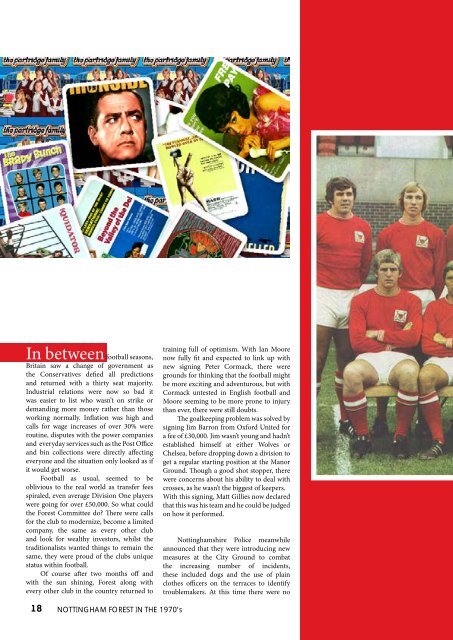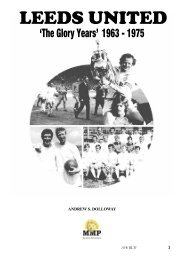NOTTINGHAM FOREST THE 1970's
You also want an ePaper? Increase the reach of your titles
YUMPU automatically turns print PDFs into web optimized ePapers that Google loves.
In between football seasons,<br />
Britain saw a change of government as<br />
the Conservatives defied all predictions<br />
and returned with a thirty seat majority.<br />
Industrial relations were now so bad it<br />
was easier to list who wasn’t on strike or<br />
demanding more money rather than those<br />
working normally. Inflation was high and<br />
calls for wage increases of over 30% were<br />
routine, disputes with the power companies<br />
and everyday services such as the Post Office<br />
and bin collections were directly affecting<br />
everyone and the situation only looked as if<br />
it would get worse.<br />
Football as usual, seemed to be<br />
oblivious to the real world as transfer fees<br />
spiraled, even average Division One players<br />
were going for over £50,000. So what could<br />
the Forest Committee do? There were calls<br />
for the club to modernize, become a limited<br />
company, the same as every other club<br />
and look for wealthy investors, whilst the<br />
traditionalists wanted things to remain the<br />
same, they were proud of the clubs unique<br />
status within football.<br />
Of course after two months off and<br />
with the sun shining, Forest along with<br />
every other club in the country returned to<br />
training full of optimism. With Ian Moore<br />
now fully fit and expected to link up with<br />
new signing Peter Cormack, there were<br />
grounds for thinking that the football might<br />
be more exciting and adventurous, but with<br />
Cormack untested in English football and<br />
Moore seeming to be more prone to injury<br />
than ever, there were still doubts.<br />
The goalkeeping problem was solved by<br />
signing Jim Barron from Oxford United for<br />
a fee of £30,000. Jim wasn’t young and hadn’t<br />
established himself at either Wolves or<br />
Chelsea, before dropping down a division to<br />
get a regular starting position at the Manor<br />
Ground. Though a good shot stopper, there<br />
were concerns about his ability to deal with<br />
crosses, as he wasn’t the biggest of keepers.<br />
With this signing, Matt Gillies now declared<br />
that this was his team and he could be judged<br />
on how it performed.<br />
Nottinghamshire Police meanwhile<br />
announced that they were introducing new<br />
measures at the City Ground to combat<br />
the increasing number of incidents,<br />
these included dogs and the use of plain<br />
clothes officers on the terraces to identify<br />
troublemakers. At this time there were no<br />
<strong>NOTTINGHAM</strong><br />
<strong>FOREST</strong><br />
FOOTBALL CLUB<br />
DIVISION ONE 1969 -70<br />
Back row, left to right:<br />
Middle row, left to right:<br />
Front row, left to right:<br />
JOHN WINFIELD ALAN HILL BOBBY McKINLAY PETER GRUMMITT<br />
BOB CHAPMAN PETER HINDLEY<br />
IAN MORE TERRY HENNESSEY PAUL RICHARDSON BARRY LYONS<br />
DAVE HILLEY HENRY NEWTON<br />
JOHN BARNWELL LIAM OKANE COLIN HALL RONNIE REES<br />
18 <strong>NOTTINGHAM</strong> <strong>FOREST</strong> IN <strong>THE</strong> 1970s<br />
<strong>NOTTINGHAM</strong> <strong>FOREST</strong> IN <strong>THE</strong> 1970s 19




